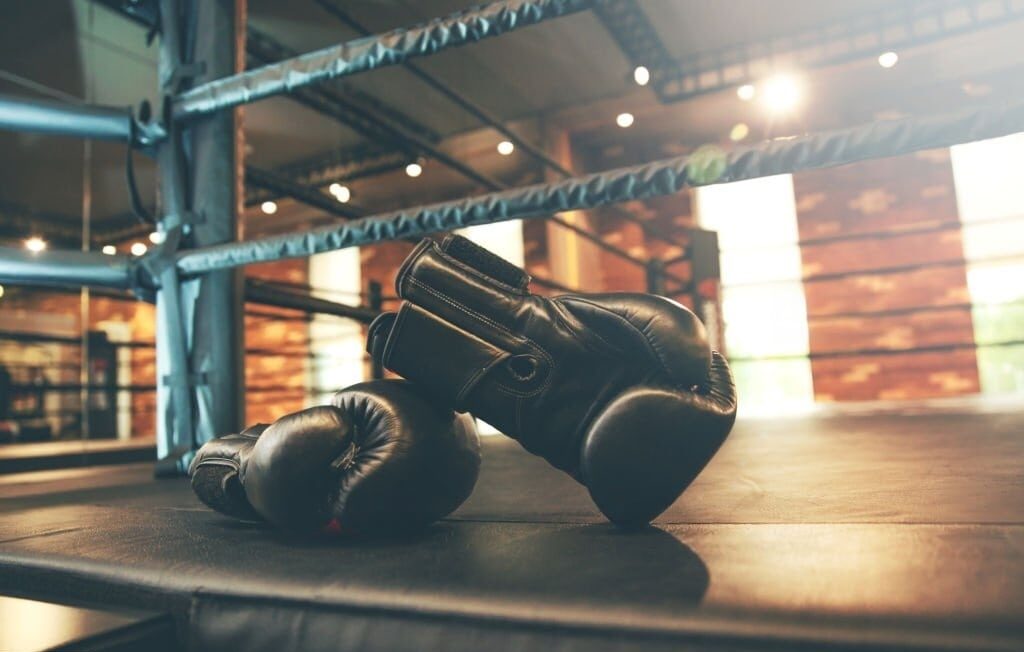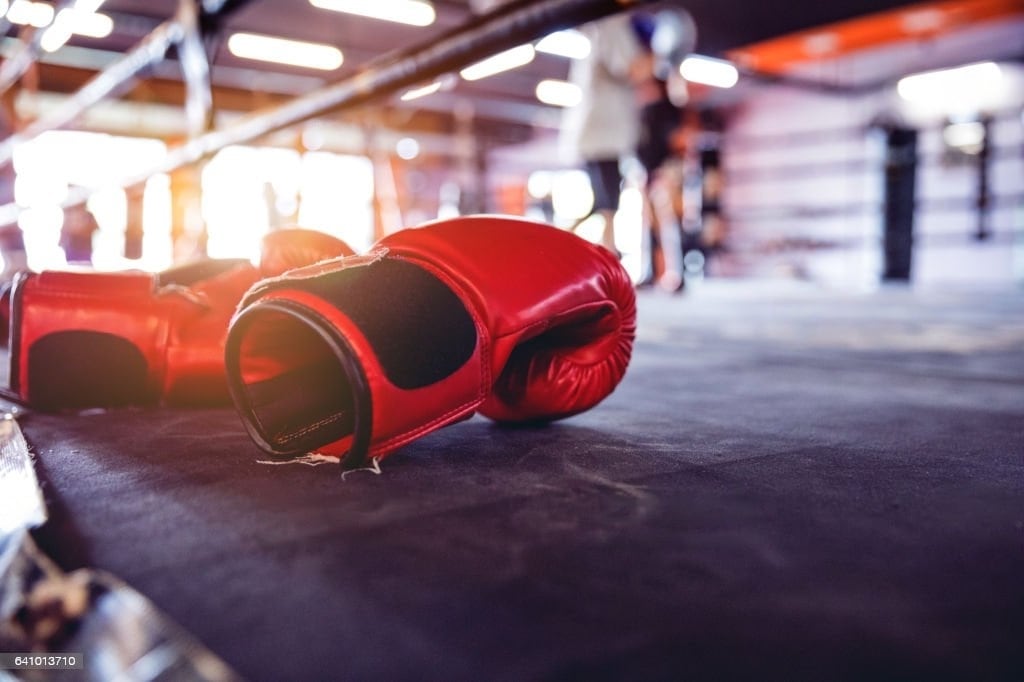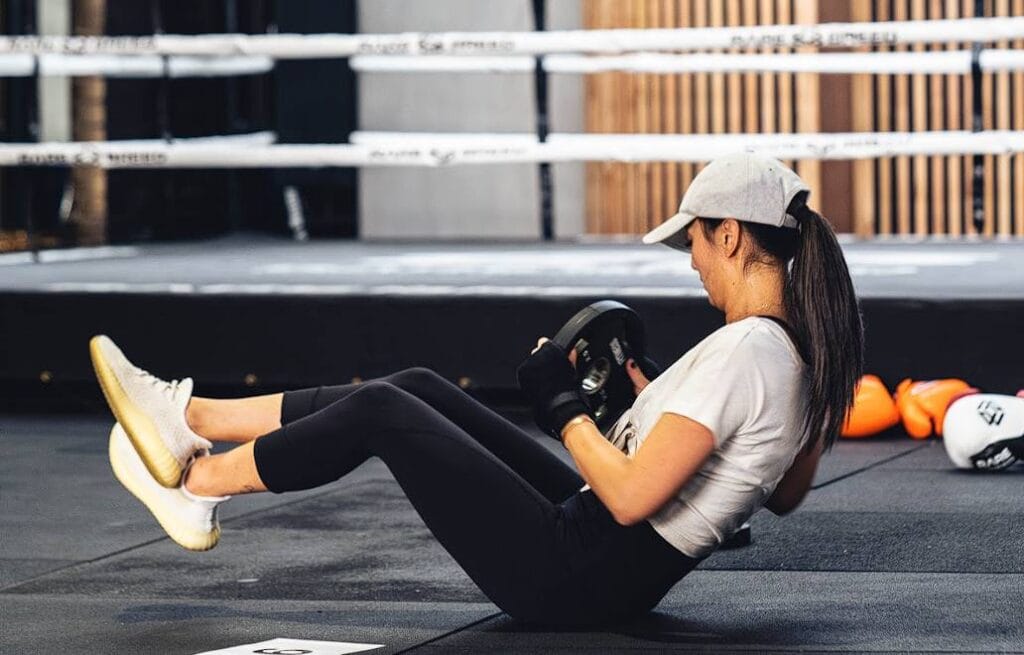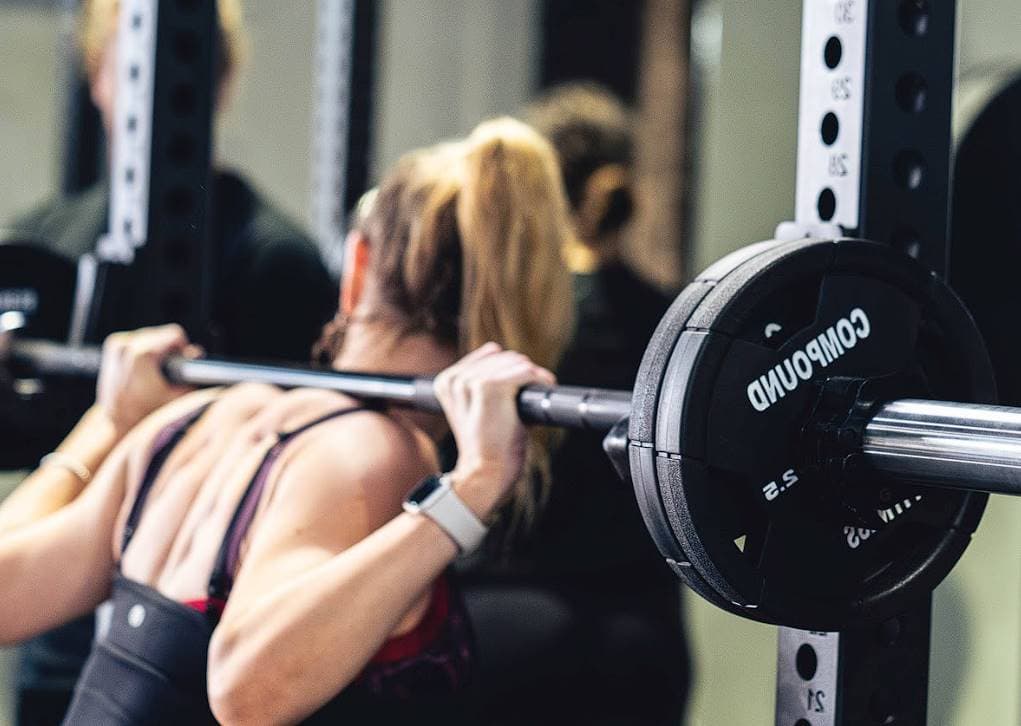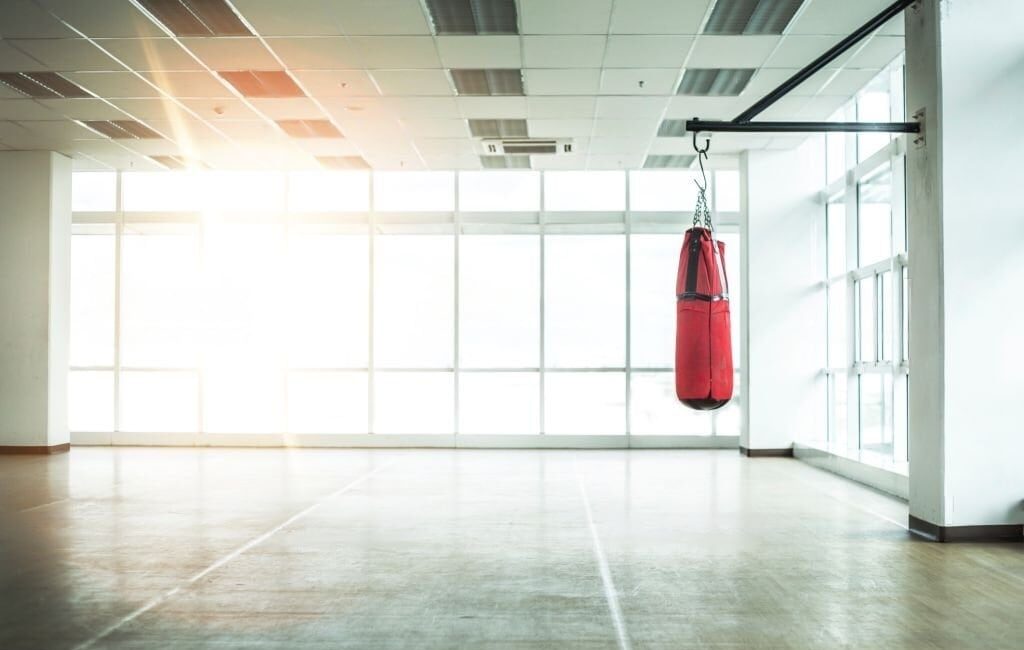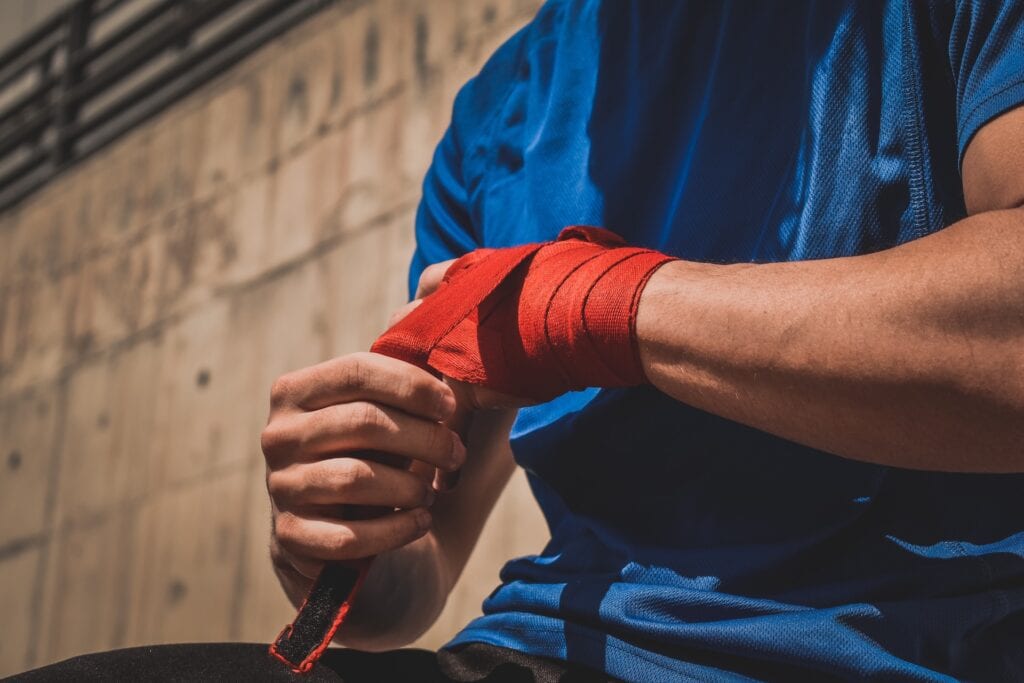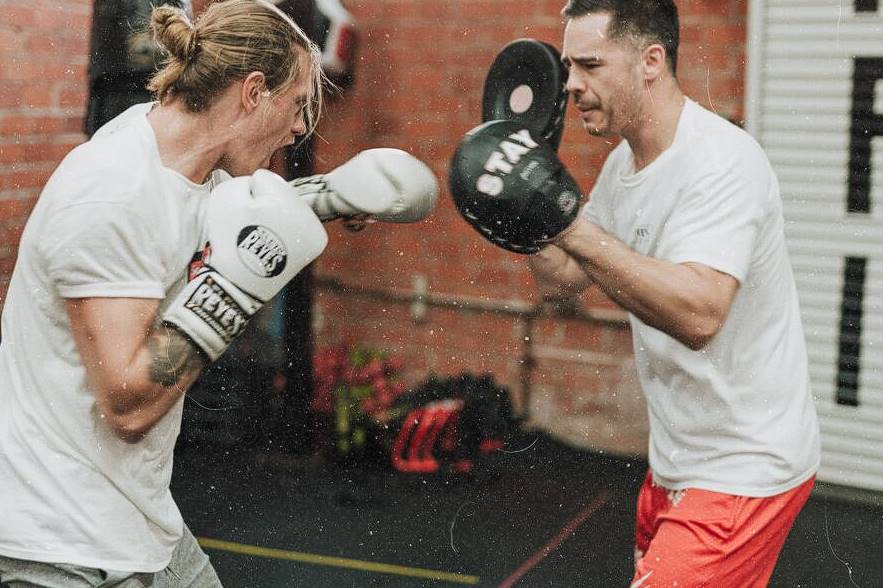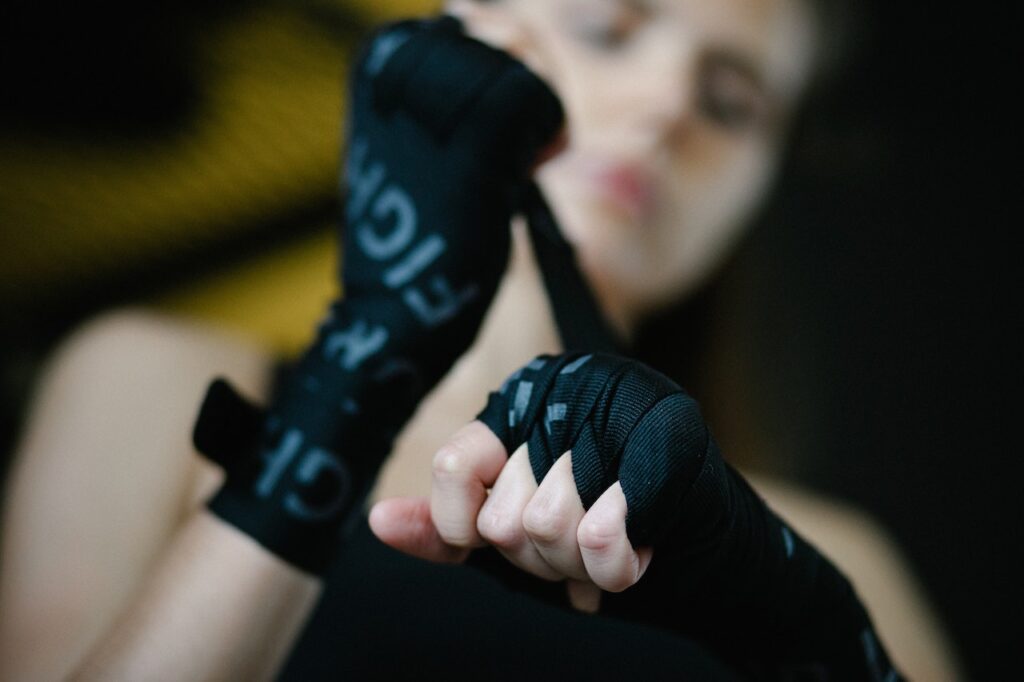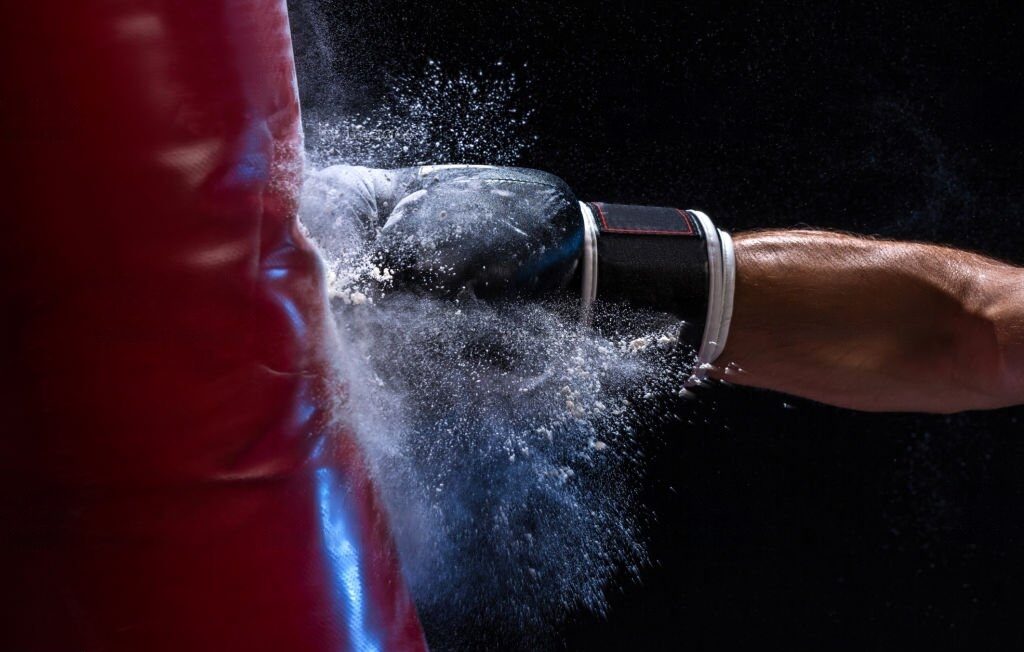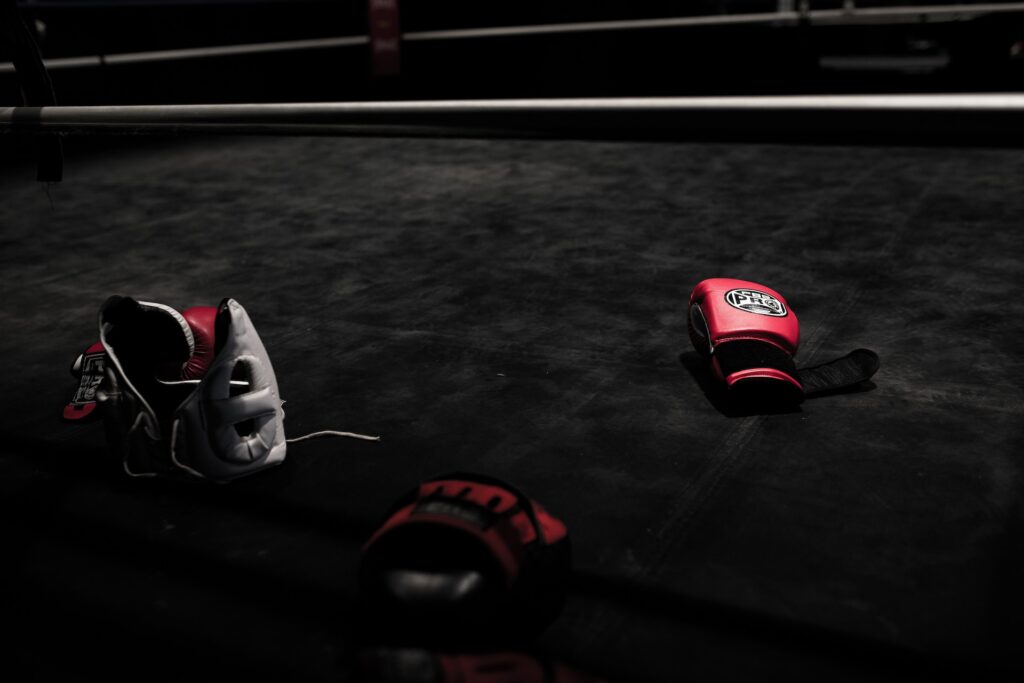When we talk about punching power in sports like boxing, Muay Thai, Mixed Martial Arts, or any other sport involving striking, we are talking about boxing, Muay Thai, and MMA. Players with stiff arms in football or offensive linemen could benefit from these exercises to increase their ability to strike.
When we think about how to improve our punching power, we need to also think about how to improve the overall power that our hands produce. That originates from our hips, feet, and trunk, respectively. Putting pressure on the ground with our feet, transferring that energy to our hips and our trunk, and finally releasing it when we throw a punch are the steps involved in boxing.
Explosiveness and power frequently set the top boxers apart from the rest of the competition. Your opponents will think twice before crowding you inside the ring if you have explosive power and superb boxing technique because such things give you tremendous punching power. In addition, because it is a unique weapon, a boxing bout can be stopped at any time and without any prior warning if the referee decides to use it.
Standard explosive workouts involve massive muscle actions like squats, power cleans, weighted or unweighted vertical jumps, heavy ball throws, and even hill sprints. These exercises are all examples of explosive exercises. Building power can also be accomplished by using smaller muscle workouts such as bench presses and push-ups; however, the results of these exercises are restricted to that specific muscle groups.
To ensure that your workouts are as effective as possible, the exercises you choose should be targeted specifically toward achieving your health and athletic objectives. Your choice of exercises should mimic the motions you perform throughout your sport.
This training rarely results in injury if you gradually raise the intensity of it over time, pay attention to your body for indicators that it may be preparing you for an accident, and collaborate with an experienced professional. Data suggest that the risk of injury in various high-speed or power sports can be reduced by consistently engaging in explosive exercise training.
Explosive Exercises for Boxing
1. One-Arm Dumbbell Press
When discussing punching power, it is important to remember that we aim to improve our relative strength. One of the fundamental principles involved working with conventional exercises that focus on resistance. For example, consider the dumbbell bench, the standard bench press, and the incline dumbbell bench press. It's OK to perform these exercises, but we must understand how they translate to increased punching power.
The first choice would be for you to perform one-arm dumbbell bench presses or alternate dumbbell presses. In this particular scenario, the primary objective is to enhance general relative strength and coordination, and the one-arm dumbbell press is the exercise you gravitate toward. While this action is being carried out, you are going to make use of the trunk. Maintain command of the eccentric, and get a sense of the pull in your stomach. Then, be sure to detonate the bomb and speed up your ascent.
Perform two to three sets of each arm, ranging from five to ten repetitions per set.
2. Shot Put Medball Throw
When focusing on relative strength, using contrast tactics is one of the best things to do. After completing the routine exercise, the one-arm dumbbell press, you should give yourself a minute of rest before moving on to the explosive med ball shot put.
This exercise aims to rotate and hit the wall with the medicine ball while catching it and then throwing it again. You intend to work on both fronts.
Therefore, start by benching on the right side, throwing a medicine ball on the same side, and then switch to benching on the left side and throwing a medicine ball on the same side. The same number of sets and reps should be used for this movement: two to three sets with five to ten repetitions each.
It will help the hands become nice and heavy, as the foot rotation into the gut and then into the hands will take place in this order. Be conscious that you will feel the exercise on the opposite side of your stomach when you press the dumbbell with one arm.
A parallel can be drawn with the throwing of the medicine ball. You will get a sense of the trigger in the stomach, which will assist in slowing down the other side and ultimately lead to increased striking force from the hands.
3. Close Grip Incline Bench
It is not frowned upon for fighters to engage in conventional lifting practices. On the other hand, you want the movement to emphasise relative power. You need to coordinate more quickly if you are going to concentrate on your respective strengths.
Therefore, one of the best things is to take a conventional lift and adapt it to focus more on speed. The other objective is to keep the number of repetitions between three and five. Although there will be some improvements in hypertrophy, the primary emphasis will be placed on power production.
During the first repetition, maintain control of the descent while using a loose grip. After that, quickly perform the concentric movement and the remaining repetitions.
The most important factor in success is your speed. Get those repetitions in! BOOM! BOOM! BOOM! BOOM! You are only concentrating on power production, particularly near the beginning of the action.
After taking a little break of roughly forty seconds, move on to the next exercise to continue your contrast training.
4. Banded Punches
Wrap a PowerLastic band around a pole, grab both handles and give a punch while using the band. Concentrate on twisting your punch with your body.
Sense how the abdominal muscles contract and the hips move by the particular punching method. It would help if you made an effort to hold the end range of the movement for an isometric muscular activity as you get a feel for the proper technique.
Isometrics is a useful tool that we can utilise to teach technical positions. In this manner, the tension will be felt throughout the body, from the trunk to the hands.
You should perform five or six sets of each exercise, alternating between the close grip incline bench and the banded punches. When performing the banded punches, you should be sure to work out both arms.
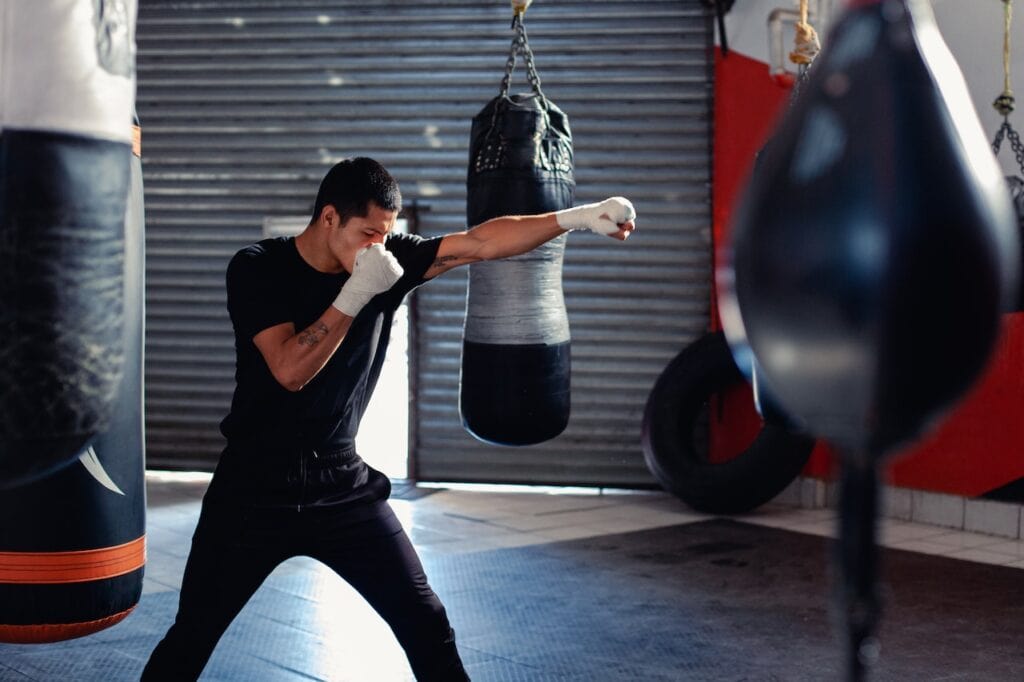
5. Glute Ham Medball Throws
There is a need for a greater emphasis on using the whole body. The hip extension is beneficial to the output of power. You will concentrate more on the movement of your trunk while in this position.
While maintaining the position, an isometric contraction will also occur in your hips, trunk, and back. In this position, you throw the medicine ball into the ground, catch it after it ricochets off the surface, and then throw it into the ground immediately after each throw.
Repeat this for five to six sets of five while pausing for ten seconds between each set. The fact that you are required to maintain equilibrium is one of the coolest aspects of this activity. You may pace it and give yourself 10 seconds to complete as many repetitions as possible in that period.
You can even make it easier on yourself by hooking in just one leg, moving to the opposite side, spinning, and then lowering the medicine ball. The most important aspect of this maneuver is to be lightning-swift, bringing the ball to the ground as rapidly as possible.
Before executing the final exercise, take a break for sixty seconds.
6. Depth Drop Into Explosive Push-Up
If you discuss the speed of coordination, you will have to understand how to absorb force. Learning proper landing mechanics with the upper body is essential to increase your punching power, which is vital.
Position yourself in a push-up position between two benches parallel to one another. First, to avoid the chest falling to the ground, you should do a depth drop and catch it. Next, perform a box leap and explode into a push-up position before landing on the benches.
It is important to absorb as rapidly as possible on the catch. The movement can be performed by either maintaining the depth drop position, exploding off the ground, or switching between reps as quickly as possible.
This exercise is ideal for any activity that requires athletes to have explosiveness in their upper body and should be practised regularly. It will translate very effectively into a powerful and explosive punching ability.
Perform this exercise for five to six sets, with five to ten repetitions in each set.
Why Use Explosive Exercises
Movements that force athletes to exert their maximum or near-maximum power in a short time are the exercises utilised to generate rapid and explosive power in athletes. Explosive exercise training ultimately creates enough power to move big weights quickly, and the training's name comes from that goal.
However, training with explosives does include the risk potential. Therefore, it is essential to begin with modest weights and move slowly and deliberately to decrease the likelihood of sustaining an injury.
It is important to gradually raise both the amount of weight utilised during a workout and the speed at which it is lifted throughout several weeks and a great number of training sessions.
Plyometric and ballistic movements are common names for the final level of explosive exercises.
Benefits
Research lends credence to the premise that explosive exercise, which emphasises both speed and strength, can increase athletic power; however, it is more beneficial when paired with other forms of training.
For instance, researchers showed that mixed maximal and explosive strength training was more effective than traditional approaches (such as circuit training) in increasing overall fitness and adaptive processes that may be helpful when increasing training loads.
It was shown in a study that was conducted on recreational endurance runners. Researchers found that this training increased overall fitness and adaptive processes (such as when a runner is training for a marathon).
Other published reports suggest that a combination of heavy and light explosive exercise provides superior results compared to either training style alone to maximise strength, power, and movement speed. It is the case when attempting to maximise strength, power, and movement speed.
Further research reveals that the initial training phase should concentrate on improving maximum strength and building a solid foundation to optimise power output or speed of movement. It should be the primary goal of this period of training. Training for both power and speed will take place during the second phase.
How to Increase Explosive Power For Boxing and MMA
Plyometrics Increase Explosive Power
Plyometric training is one of the most effective ways to build explosive power and is becoming increasingly popular.
Plyometric training is a type of exercise that comprises movements performed at a slower-than-normal speed, followed by a rapid and explosive movement that is performed at a faster-than-normal speed.
Plyometric training is also known as reactionary training, which involves putting a muscle through a stretch followed by a rapid contraction to generate an explosive movement.
The strangest thing about plyometric training is that coaches and fighters have traditionally ignored and underestimated it. It is a peculiar thing about plyometric training.
Most boxers don't engage in plyometric training aside from the traditional box jump since they don't consider their bodies to be a single unit. They believe that when you deliver punches and strikes with your upper body, you do not require explosive force in your legs since you use your upper body.
Big error.
When it comes to improving your explosive power for boxing and mixed martial arts performance, exercises like broad leaps, tuck jumps, pogo jumps, and power skips can be quite beneficial. In addition, the various functions and joints of the lower extremities are developed due to these movements.
Here are some plyometric workouts to develop your explosive power for your boxing and mixed martial arts performances:
1. Pogos
Pogo sticks are a form of low-intensity plyometric exercise that are fantastic for enhancing suppleness in the ankle complex. When performing plyometric exercises, the ankle is sometimes neglected; nonetheless, improving its force production and absorption capacities is essential because it is the first joint that comes into contact with the ground during most activities.
Pogos are easy if you follow these steps:
- Begin by spacing your feet hip-width apart.
- Maintain a comfortable stance on the knees.
- You may nudge the floor away from you by utilising some arm movement and the force from your ankles.
- When you land, do it gently and immediately start pushing yourself back up.
- Keep in mind that the focus is on the ankle; hence, attempt to reduce the amount of knee involvement.
- Perform for desired time.
2. Broad Jumps
Another excellent plyometric movement that targets the posterior chain is the broad jump. This plyometric places a significant emphasis on triple extension, specifically hip extension, which most boxers lack.
The broad leap is an extremely versatile exercise that can easily progress and regress. It will also play a direct part in boosting the strength of your strikes, whether those strikes be punches or kicks. Broad jumps may be performed anywhere, at any time.
The following describes how to perform broad jumps:
- Maintain your erect posture with your feet spaced and your arms raised.
- Swing your arms down while simultaneously bringing your hips back and bending your knees just a little bit.
- Next, rapidly swing the arms, extend the hips and knees, and jump as far as possible in a horizontal direction.
- Land gently, then repeat for the appropriate number of repetitions.
3. Power Skips
The power skip is a fantastic drill that benefits athletes of all skill levels. Depending on your choice, they can be done for height or distance and have varying carryovers to your explosive power.
They are also excellent for building power endurance if you perform them over greater distances or longer periods.
The following guide on performing power skips
- Put yourself in a standing position to begin.
- Next, take a step forward and put your weight on the leg you just stepped with.
- Next, raise the knee of the opposite leg into the air.
- Next, raise the arm that is opposite the knee that is raised to your cheek.
- When you land gently, repeat the process on the opposite side.
- Iterate as many times as desired repetitions.
Weighted Plyometrics
1. Trap Bar Deadlift Jumps
Plyometric exercises like trap bar deadlift jumps are one of my favourites for several reasons. To begin, they are not in danger. The position of your spine is not jeopardised as it would be during barbell squat jumps when you do them instead.
They are also quite easy to obtain for the majority of lifters.
In addition to all of that, they are highly useful when it comes to raising the force of explosions.
It is essential to keep in mind that the most important thing here is quality. Particularly while performing weighted plyometrics, you don't want to slack off, or you run the danger of injuring yourself.
It would be best if you came to a complete halt between each hop to execute this action properly. However, it is done so you can reset, get into the appropriate position, and leap.
The following describes how to perform trap bar deadlift jumps
- After entering the trap bar, position your feet to be hip-width apart in the centre.
- Place the butt down and slightly push the hips back to grip the handles in the middle of each position.
- Maintain a downward and backward shoulders tilt, generate tension in the hips, and force yourself off the ground.
- Stop the bar completely, then perform the required repetitions.
2. Weighted Box Jumps
Box jumps with weights are another very adaptable exercise. Again, you can access many tools to try out various permutations to discover what works best. For example, you can work the concentric element of the movement by doing them without including any counter movement at all. You can even make them more reactive by having them jump from one box to another after dropping from the first box.
When it comes to this particular item, you have a plethora of choices.
Ballistics to Increase Explosive Power
Ballistic training is one of the most effective power training methods.
In its most basic form, ballistic training can be defined as any exercise in which the athlete throws a weight to develop explosive power.
Some people believe that weighted plyometrics fit into this category; nevertheless, the factor that sets ballistics apart from plyometrics is that ballistic training focuses on concentric motions.
If you were unaware, the section of the action known as the concentric portion is the portion of the movement in which the weight is being actively overcome. In the squat, the deadlift, and the bench press, this is the "up" component of the movement.
In general, ballistics places a greater emphasis on this section of the movement. In contrast, plyometrics emphasises the movement's eccentric phase, which is followed by a rapid rebound or contraction of the muscles.
If you want your ballistics training to be effective, you need to select a weight that enables you to move swiftly, sharply, and with as much power as possible. Therefore, your primary concentration will be on boosting explosive power and activating those fast-twitch muscle fibres by training in this manner.
Your objective is to generate the most force in the shortest time possible.
The following are some of the best ballistic moves for increasing explosive power in boxing and mixed martial arts:
1. Fight-Specic Medball Throw
The medal throw used specifically for fighting is intended to pack additional power behind your cross. It is highly particular to the fight game in that you will be standing in your fight stance, creating force from your legs and transferring it through your body to propel the medicine ball towards the wall with as much force as possible.
Keep in mind that quality must be maintained.
You want to do your repetitions promptly. Therefore, maintain a clear focus while ensuring that everything is spotless.
Imagine you can throw the ball so that it goes through the wall. Not simply a matter of getting the ball against the wall.
The fight-specific med ball throw is performed in the following manner:
- Put yourself in a fighting stance and face the wall in a perpendicular direction.
- Keep the medicine ball held high by your chin.
- When throwing the medicine ball at the wall, you should generate force via your legs, core, and upper extremities.
- Perform the necessary number of repetitions on both sides.
2. Medball Rotational Slam
The benefits of performing med ball rotational smashes are numerous and extensive.
First, you build your explosive strength while conditioning the core to contract explosively.
By asymmetrically smashing the ball, you can improve not only your coordination but also your balance.
The following describes performing a med ball rotational slam:
- Begin by spacing your feet hip-width apart.
- Then, gather the medicine ball together.
- Lift the medicine ball high as quickly as possible while stretching your hips and knees.
- Flip the ball and hammer it down with your right foot.
- It should be repeated on the opposite side.
- Continue until you reach your desired reps.
3. Medball Side Toss
The med ball side toss is an excellent activity for developing rotational force, an essential component of boxing and mixed martial arts (MMA).
Because your arms are acting only as levers in this movement, most of the force generated for this movement originates from your legs and your core.
The following describes how to perform the med ball side toss:
- Begin by positioning the feet as they are just outside the width of the hips while standing perpendicular to the wall.
- Put some weight on the medicine ball and load it up by your back hip.
- While you are doing so, slightly bend your knees.
- To throw the medicine ball against the wall, generate force through the ground, then extend the knees and rotate the core to face the wall.
- Perform the necessary number of repetitions on both sides.
How Many Reps Should You Perform for Explosive Power?
When striving to develop your explosive power, you should emphasise the quality of your training more than the number.
You do not want to be weary when you are performing your power movements (unless you are aiming to develop some specific traits). Thus sets of six or more are an absolute no-no.
Reduce the number of repetitions to no more than five.
In addition, ensure that you get enough rest in between sets to do the exercise with the utmost quality, precision, and intent.
It is much more difficult to kick a bad habit than to form a good one.

When Should Power Exercises Be Performed?
In most cases, you should perform your power exercises right after you've finished your warm-up and mobility work.
It is true for two different reasons.
The first issue is that activities that need explosive force are quite stressful on the nervous system. In light of this information, you can deduce that explosive power exercises are stressful on the neurological system.
Therefore, when you perform them after your workout when you are already shaking from them, the quality and intent of your performance will suffer.
If your strength is your top priority, you want to avoid being gassed while doing your strength training.
When it comes to developing one's physical strength, achieving high quality in one's workouts is of the utmost importance, which is why strength training activities should be performed first.
To reiterate, executing actions that rely largely on sharpness and intent at the very end of the training session would make perfect sense.
6 Ways to Develop Explosiveness And Power for Boxing
Are you ready to make your devastating punching power one of your defining characteristics as a boxer? To build your explosiveness and power for boxing, you should practice some of the following things:
1) Strengthen Your Core
Your core muscles are the muscles that respond to maintaining your body's stability and strength. Your abdominal muscles, lower back muscles, and the muscles that support your spine are all included in this group since they are all positioned in the middle of your body.
Core strength training is essential for athletes because it helps them improve their balance and stability. For example, boxers who work on improving their core strength see an increase in the power of their punches, given that a portion of the power in their blows comes from their core.
In addition, building up the strength of your abdominal muscles can also increase your stability, helping you to maintain your balance even while you deliver strong blows.
2) Connect With The Canvas When Throwing Strikes
When you are inside a boxing ring, the canvas acts as a spring, so picture it that way. By planting your feet firmly on the ground and sinking your toes in, you may produce more power for your punches and use the canvas as a springboard.
As a result, your toes and feet should spring back up with plenty of vigour and power. It will be of utmost significance when landing from a jump or pushing off from a starting position. To get the most out of your explosiveness and, as a result, your strength, you must immediately connect with that springy feeling.
3) Improve Your Technique
When developing explosive power, one of the most important things you can do is perfect your form. It will be easier for you to successfully transmit the energy from your body into a punch if you have strong technique. When trying to increase your explosiveness for boxing, keep the following suggestions in mind:
- Maintain a wide stance with your shoulders pulled back. As a result, excessive movement is reduced, and energy is transferred into each hit.
- When you throw punches, ensure your elbows are tucked in so they don't get hit. It is also important to keep your elbows up while delivering power swings so that you do not leave yourself open to counterpunches from your opponent.
As a boxer, improving your form will automatically improve your power and explosiveness. As you swing away, it will let you create more power with your lower body and torso.
4) Improve Your Speed
When you throw punches, the power of your blows is directly proportional to the speed with which your hands move. Because of this, you should allocate some of your training time to activities that focus on increasing your hand speed to boost the punching power you possess.
Boxers can enhance their hand speed in several useful ways, including the following:
- Hand Weights: When shadowboxing or conducting other boxing exercises, holding onto dumbbells or wrapping wrist weights on your wrists can help you build up your hand speed, power, and endurance. When you remove the weights, you will find that each punch you throw is significantly more powerful, allowing you to throw punches faster.
- Focus Mitts: Focus mitts are a useful addition to your training regimen if your goal is to increase your speed. Your hand-eye coordination, footwork, defensive positioning, and punching accuracy will all benefit from this activity. For example, when you're working out, your training partner or trainer could shout out combinations or punches, and you should strive to land them as rapidly as possible.
- Boxing hand speed can be significantly improved by engaging in speed bag drills, among the most used training methods. When you finally get the hang of it, hitting a speed bag can also be great fun. First, you should learn how to strike the bag in a consistent rhythm, and then you may work on increasing your pace. Your hand speed will increase proportionately to the rate at which you can work a speed bag. You may improve your punch accuracy, timing, rhythm, and hand-eye coordination by working on these skills with speed bags. These skills can offer you an advantage over your opponents when you are boxing.
5) Hit Heavy Bags
Working out with heavy bags helps you increase your strength, as well as your speed and endurance. If your hands start to feel tired one minute into each round, having fast hands will only help you a little, no matter how fast they are. Your body will become accustomed to hitting an actual item and to the impact that this has on your hands and arms when you utilise a heavy bag.
When working out on a heavy bag, it is best to enlist the assistance of a training partner who can hold the bag steady for you. When you strike the bag this way, it doesn't move much, similar to how a real opponent wouldn't move much after most punches are thrown at them.
Interval training is beneficial when working out with a heavy bag. After that, you must grab a training partner and set the timer for three-minute rounds. You give the bag as much force as possible for approximately twenty seconds, and your training partner gets a turn.
The procedure is repeated until the round is complete, after which you will have a one-minute break. Your goal should be to complete as many rounds as your body can. Try wearing wrist weights if you want more of a challenge while working on the bag.
6) Plyometrics
The explosive power you possess can be improved through plyometric activities. Plyometrics is explosive strength training that lets you get the most out of your workouts. Plyometrics is superior to other forms of explosive strength training because it emphasises explosive movement.
For instance, traditional strength training exercises such as squats can be performed explosively; however, you still need to spend the last portion of each rep decelerating the weight rather than accelerating it.
Explosive movements require more force than slower, more controlled movements. If you don't slow the weight down, it will shoot out of your hands and hurt you.
The need to slow down between repetitions is eliminated when you perform plyometric workouts, providing you with a more efficient means of developing your explosive strength. Boxers should include plyometric workouts as part of their regular training routine:
- Jumping Squats are an excellent workout for developing explosive strength in your legs. It is the same as executing bodyweight squats, except that you jump off the ground after each repetition. Consider wearing a weighted vest if you want more of a challenge.
- Plyometric Pushups are an excellent exercise for developing your explosive power in the chest, shoulders, and triceps. It's very similar to a regular pushup, except instead of lifting your hands off the ground at the top, you perform an explosive pushdown on the floor at the top of the movement.
- Medicine Ball Slams are an excellent workout for developing explosive power in the upper body and strengthening the abdominal region.
Conclusion
Explosive exercises, also known as exercises that test a person's strength and speed, can improve a person's physical performance in a variety of high-intensity sports and may lower the risk of injury for athletes participating in activities that require high power outputs combined with rapid acceleration. These activities include the majority of racket and field sports.
Be careful to work on increasing your rate of coordination and relative strength. When you practice this, you will develop enormous knockout power, allowing you to take control of the situation within the ring.
The body is used to throw heavy hands, beginning with the feet, moving into the hips, passing through the trunk, and finally making contact with the target through the fist. Therefore, it is essential to work on increasing your coordination rate to make your fist's impact more comparable to that of Mike Tyson.
Frequenly Asked Questions
Why are explosive exercises important for boxing?
Explosive exercises are crucial for boxing as they help boxers generate maximum power and speed in their punches, footwork, and defensive maneuvers. These exercises train the muscles to contract rapidly and forcefully, which translates into faster punches, quicker footwork, and more impactful strikes. They also improve overall athleticism, agility, and reaction time, making boxers more effective and formidable in the ring.
Why are explosive exercises important for boxing?
Explosive exercises are crucial for boxing as they help boxers generate maximum power and speed in their punches, footwork, and defensive maneuvers. These exercises train the muscles to contract rapidly and forcefully, which translates into faster punches, quicker footwork, and more impactful strikes. They also improve overall athleticism, agility, and reaction time, making boxers more effective and formidable in the ring.
What are some effective explosive exercises for boxing?
There are several effective explosive exercises that boxers can incorporate into their training routines. Some examples include:
- Plyometric exercises: Box jumps, clap push-ups, and medicine ball throw.
- Olympic lifts: Clean and jerk, snatch, and power cleans.
- Medicine ball exercises: Rotational throws, overhead slams, and explosive push-passes.
- Resistance training: Squat jumps, kettlebell swings, and explosive lunges.
It's important to note that these exercises should be performed with proper form, gradually increased intensity, and under the supervision of a qualified trainer to prevent injury and maximize benefits.
How often should explosive exercises be included in a boxing training program?
The frequency of incorporating explosive exercises into a boxing training program may vary depending on the boxer's individual needs, goals, and overall training schedule. Generally, it is recommended to include explosive exercises 2-3 times per week, alongside other forms of strength and conditioning training. However, it is crucial to listen to your body, avoid overtraining, and allow adequate recovery time between sessions to prevent fatigue and injuries.
Can explosive exercises help improve punching power?
Yes, explosive exercises can significantly improve punching power in boxing. These exercises enhance the boxer's ability to generate force from the legs, transfer it through the core, and deliver it with explosive speed and precision. By strengthening the muscles involved in punching movements and developing fast-twitch muscle fibres, explosive exercises can help boxers increase their power output and deliver more impactful punches.

